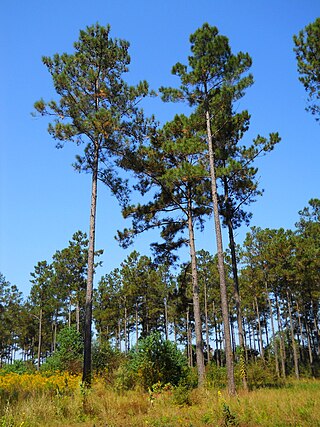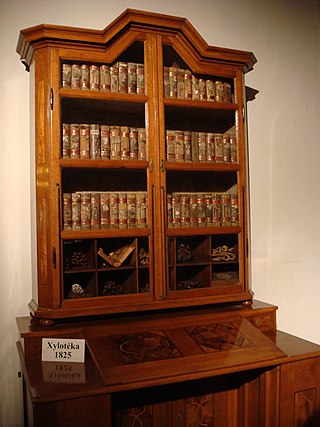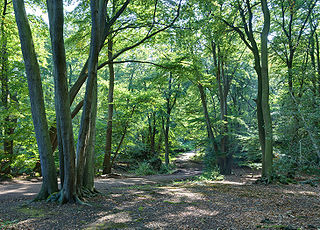The Arkansas Champion Tree Program is a listing of the largest known specimens of particular tree species in the U.S. state of Arkansas. It is updated every five years by the Arkansas Forestry Commission. The program was modeled on the National Register of Big Trees, started by the American Forests organization in 1940. The goal of Arkansas's program is to record, heighten awareness of, and preserve the largest tree specimens in the state. It uses the same formula for recording tree specimens that was developed by American Forests. Former champions are removed from the list as new, larger, champions are identified and recorded. The program had a total of 130 Champion Trees listed. [1]

Forestry is the science and craft of creating, managing, planting, using, conserving and repairing forests and woodlands for associated resources for human and environmental benefits. Forestry is practiced in plantations and natural stands. The science of forestry has elements that belong to the biological, physical, social, political and managerial sciences. Forest management plays an essential role in the creation and modification of habitats and affects ecosystem services provisioning.
The Forestry Commission is a non-ministerial government department responsible for the management of publicly owned forests and the regulation of both public and private forestry in England.

A forester is a person who practises forestry, the science, art, and profession of managing forests. Foresters engage in a broad range of activities including ecological restoration and management of protected areas. Foresters manage forests to provide a variety of objectives including direct extraction of raw material, outdoor recreation, conservation, hunting and aesthetics. Emerging management practices include managing forestlands for biodiversity, carbon sequestration and air quality.

Pinus taeda, commonly known as loblolly pine, is one of several pines native to the Southeastern United States, from East Texas to Florida, and north to southern New Jersey. The wood industry classifies the species as a southern yellow pine. U.S. Forest Service surveys found that loblolly pine is the second-most common species of tree in the United States, after red maple. For its timber, the pine species is regarded as the most commercially important tree in the Southeastern U.S. The common name loblolly is given because the pine species is found mostly in lowlands and swampy areas.

The Wye Oak was the largest white oak tree in the United States and the State Tree of Maryland from 1941 until its demise in 2002. Wye Oak State Park preserves the site where the revered tree stood for more than 400 years in the town of Wye Mills, Talbot County, Maryland.

Ulmus crassifoliaNutt., the Texas cedar elm or simply cedar elm, is a deciduous tree native to south-central North America, mainly in southern and eastern Texas, southern Oklahoma, Arkansas, and Louisiana, with small populations in western Mississippi, southwest Tennessee, and north-central Florida; it also occurs in northeastern Mexico. It is the most common elm tree in Texas. The tree typically grows well in flat valley bottom areas referred to as cedar elm flats. Its Latin name refers to its comparatively thick (crassifoliate) leaves; the common name cedar elm is derived from the trees' association with juniper trees, locally known as cedars.

Glen Affric is a glen south-west of the village of Cannich in the Highland region of Scotland, some 15 miles west of Loch Ness. The River Affric runs along its length, passing through Loch Affric and Loch Beinn a' Mheadhoin. A minor public road reaches as far as the end of Loch Beinn a' Mheadhoin, but beyond that point only rough tracks and footpaths continue along the glen.

A xylotheque or xylothek is special form of herbarium that consists of a collection of authenticated wood specimens. It is also known as a xylarium. Traditionally, xylotheque specimens were in the form of book-shaped volumes, each made of a particular kind of wood and holding samples of the different parts of the corresponding plant. While the terms are often used interchangeably, some use xylotheque to refer to these older collections of wooden 'books' and xylarium for modern collections in which some or all of the specimens are in simpler shapes, such as blocks or plaques with information engraved on their surfaces. Many countries have at least one xylotheque with native flora, and some also house flora from other parts of the world. They are valuable to specialists in forestry, botany, conservation, forensics, art restoration, paleontology, archaeology, and other fields.
The National Register of Champion Trees is a list of the largest tree specimens found in the United States as reported to American Forests by the public. A tree on this list is called a National Champion Tree.
American Forests is a 501(c)(3) non-profit conservation organization, established in 1875, and dedicated to protecting and restoring healthy forest ecosystems. The current headquarters are in Washington, D.C.

Yale School of the Environment (YSE) is a professional school of Yale University. It was founded to train foresters, and now trains environmental students through four 2-year degree programs, two 10-month mid-career programs, and a 5-year PhD program. Still offering forestry instruction, the school has the oldest graduate forestry program in the United States.

Ulmus serotinaSarg., the September elm, is an autumn-flowering North American species of tree. It is uncommon beyond Tennessee; it is only very locally distributed through Illinois, Kentucky, Arkansas, Mississippi, Oklahoma, Alabama, and Georgia, and disjunct populations into Nuevo León, Mexico. It grows predominantly on limestone bluffs and along streams to elevations of 400 m.

The hybrid cultivar Ulmus × hollandica 'Cicestria', commonly known as the 'Chichester Elm', was cloned at the beginning of the 18th century from a tree growing at Chichester Hall, Rawreth, near Danbury, Essex, England, then the home of Thomas Holt White FRS, brother of the naturalist Gilbert White. The tree was first recorded by country parson and botanist Adam Buddle in south-east Essex in 1711, and appeared as U. cicestria in an 1801 catalogue. 'Cicestria' is the original Ulmus × hollandica 'Vegeta', but suffered confusion with the later Huntingdon Elm cultivar by John Claudius Loudon who, without consulting Lindley, accorded the epithet 'Vegeta' to Huntingdon Elm in 1838, as he found the two indistinguishable. J. E. Little in The Journal of Botany (1923) agreed that Buddle's leaves-specimen of Chichester Elm in the Sloane Herbarium seemed to be the same cultivar as Huntingdon Elm: "If so, this elm [Chichester] was in existence and mature some years before the reputed raising of the Huntingdon Elm by Wood of Huntingdon 'about 1746'."

Forestry in India is a significant rural industry and a major environmental resource. India is one of the ten most forest-rich countries of the world. Together, India and 9 other countries account for 67 percent of the total forest area of the world. India's forest cover grew at 0.20% annually over 1990–2000, and has grown at the rate of 0.7% per year over 2000–2010, after decades where forest degradation was a matter of serious concern.

The United Kingdom, being in the British Isles, is ideal for tree growth, thanks to its mild winters, plentiful rainfall, fertile soil and hill-sheltered topography. In the absence of people, much of Great Britain would be covered with mature oaks, except for Scotland. Although conditions for forestry are good, trees face threats from fungi, parasites and pests. Nowadays, about 13% of Britain's land surface is wooded. European countries average 39%, but this varies widely from 1% (Malta) to 66% (Finland). As of 2021, government plans call for 30,000 hectares to be reforested each year. Efforts to reach these targets have attracted criticism for planting non-native trees, or trees that are out of place for their surroundings, leading to ecological changes.

Scotland is ideal for tree growth, thanks to its mild winters, plentiful rainfall, fertile soil and hill-sheltered topography. As of 2019 about 18.5% of the country was wooded. Although this figure is well below the European Union (EU) average of 43%, it represents a significant increase compared to the figure of 100 years previously: in 1919 it was estimated that only 5% of the country's total land area was covered in forest. The Scottish Government's Draft Climate Change Plan has set an aim of increasing coverage to 21% of Scotland by 2032, with the rate of afforestation rising to 15,000 hectares per year by 2024.
The Alabama Champion Tree Program is a listing of the largest known specimens of particular tree species, native or introduced, in the U.S. state of Alabama. It was established in 1970 by the Alabama Forestry Commission. The program was modeled on the National Register of Big Trees, started by the American Forests organization in 1940. The goal of Alabama's program is to record, heighten awareness of, and preserve the largest tree specimens in the state. It uses the same formula for recording tree specimens that was developed by American Forests. Former champions are removed from the list as new, larger, champions are identified and recorded. Although introduced species that have naturalized are generally eligible for the program, those species that the Alabama Invasive Plant Council considers to be invasive were removed from the listing in 2011 and are no longer eligible. With the addition of 20 new specimens in 2011, the program had a total of 159 Champion Trees listed.
Trees have a wide variety of sizes and shapes and growth habits. Specimens may grow as individual trunks, multitrunk masses, coppices, clonal colonies, or even more exotic tree complexes. Most champion tree programs focus finding and measuring the largest single-trunk example of each species. There are three basic parameters commonly measured to characterize the size of a single trunk tree: tree height measurement, tree girth measurement, and tree crown measurement. Foresters also perform tree volume measurements. A detailed guideline to these basic measurements is provided in The Tree Measuring Guidelines of the Eastern Native Tree Society by Will Blozan.